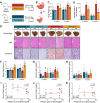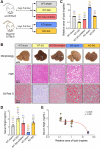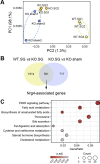Lipid metabolic reprogramming mediated by circulating Nrg4 alleviates metabolic dysfunction-associated steatotic liver disease during the early recovery phase after sleeve gastrectomy
- PMID: 38632600
- PMCID: PMC11025198
- DOI: 10.1186/s12916-024-03377-0
Lipid metabolic reprogramming mediated by circulating Nrg4 alleviates metabolic dysfunction-associated steatotic liver disease during the early recovery phase after sleeve gastrectomy
Abstract
Background: The metabolic benefits of bariatric surgery that contribute to the alleviation of metabolic dysfunction-associated steatotic liver disease (MASLD) have been reported. However, the processes and mechanisms underlying the contribution of lipid metabolic reprogramming after bariatric surgery to attenuating MASLD remain elusive.
Methods: A case-control study was designed to evaluate the impact of three of the most common adipokines (Nrg4, leptin, and adiponectin) on hepatic steatosis in the early recovery phase following sleeve gastrectomy (SG). A series of rodent and cell line experiments were subsequently used to determine the role and mechanism of secreted adipokines following SG in the alleviation of MASLD.
Results: In morbidly obese patients, an increase in circulating Nrg4 levels is associated with the alleviation of hepatic steatosis in the early recovery phase following SG before remarkable weight loss. The temporal parameters of the mice confirmed that an increase in circulating Nrg4 levels was initially stimulated by SG and contributed to the beneficial effect of SG on hepatic lipid deposition. Moreover, this occurred early following bariatric surgery. Mechanistically, gain- and loss-of-function studies in mice or cell lines revealed that circulating Nrg4 activates ErbB4, which could positively regulate fatty acid oxidation in hepatocytes to reduce intracellular lipid deposition.
Conclusions: This study demonstrated that the rapid effect of SG on hepatic lipid metabolic reprogramming mediated by circulating Nrg4 alleviates MASLD.
Keywords: Early postoperative recovery phase; Fatty acid oxidation; Lipid metabolic reprogramming; Metabolic dysfunction-associated steatotic liver disease; Neuregulin-4; Sleeve gastrectomy.
© 2024. The Author(s).
Conflict of interest statement
The authors declare that they have no competing interests.
Figures







Similar articles
-
Exercise-induced adipokine Nrg4 alleviates MASLD by disrupting hepatic cGAS-STING signaling.Cell Rep. 2025 Feb 25;44(2):115251. doi: 10.1016/j.celrep.2025.115251. Epub 2025 Jan 30. Cell Rep. 2025. PMID: 39891907
-
Weight Loss After Sleeve Gastrectomy According to Metabolic Dysfunction-Associated Steatotic Liver Disease Stage in Patients with Obesity: A Liver Biopsy-Based Prospective Study.Nutrients. 2024 Nov 12;16(22):3857. doi: 10.3390/nu16223857. Nutrients. 2024. PMID: 39599643 Free PMC article.
-
Multiomics analyses decipher intricate changes in the cellular and metabolic landscape of steatotic livers upon dietary restriction and sleeve gastrectomy.Int J Biol Sci. 2024 Aug 19;20(11):4438-4457. doi: 10.7150/ijbs.98362. eCollection 2024. Int J Biol Sci. 2024. PMID: 39247824 Free PMC article.
-
A systematic review of the association of neuregulin 4, a brown fat-enriched secreted factor, with obesity and related metabolic disturbances.Obes Rev. 2020 Feb;21(2):e12952. doi: 10.1111/obr.12952. Epub 2019 Nov 28. Obes Rev. 2020. PMID: 31782243
-
Endoscopic bariatric and metabolic therapies and its effect on metabolic dysfunction-associated steatotic liver disease: a review of the current literature.Surg Obes Relat Dis. 2025 Feb;21(2):175-182. doi: 10.1016/j.soard.2024.09.012. Epub 2024 Oct 9. Surg Obes Relat Dis. 2025. PMID: 39510869 Review.
Cited by
-
Crosstalk between fat tissue and muscle, brain, liver, and heart in obesity: cellular and molecular perspectives.Eur J Med Res. 2024 Dec 31;29(1):637. doi: 10.1186/s40001-024-02176-w. Eur J Med Res. 2024. PMID: 39741333 Free PMC article. Review.
References
-
- Chambers AP, Jessen L, Ryan KK, Sisley S, Wilson-Perez HE, Stefater MA, Gaitonde SG, Sorrell JE, Toure M, Berger J, et al. Weight-independent changes in blood glucose homeostasis after gastric bypass or vertical sleeve gastrectomy in rats. Gastroenterology. 2011;141(3):950–958. doi: 10.1053/j.gastro.2011.05.050. - DOI - PMC - PubMed
-
- Li K, Zou JA, Li S, Guo J, Shi WT, Wang B, Han XD, Zhang HW, Zhang P, Miao ZM, et al. Farnesoid X receptor contributes to body weight-independent improvements in glycemic control after Roux -en -Y gastric bypass surgery in diet-induced obese mice. Molecular Metabolism. 2020;37:100980. doi: 10.1016/j.molmet.2020.100980. - DOI - PMC - PubMed
Publication types
MeSH terms
Substances
Grants and funding
- 82070917/National Natural Science Foundation of China
- YBKB202219/the Project of Biobank (NO. YBKB202219) from Shanghai Ninth People's Hospital, Shanghai JiaoTong University School of Medicine
- JYLJ202216/the Clinical Research Program (NO. JYLJ202216) of 9th People's Hospital affiliated to Shanghai JiaoTong University School of Medicine.
LinkOut - more resources
Full Text Sources
Medical

